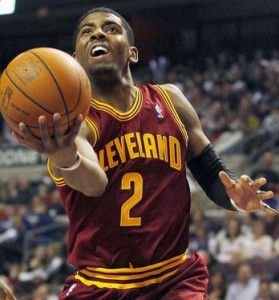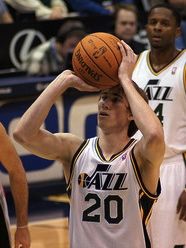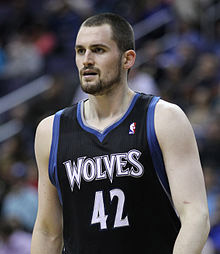Draft Planning
& Auction Strategies
In Parts 1, 2, 3 and 4 of this series, I introduced you to the Fantasy Basketball Primer, reviewed Head-to-Head, Rotisserie and Keeper League strategies, shared strategies for certain league customizations and showed you how to find sleepers.
Today, we look at transforming that information into a draft plan for snake-style drafts and some basic auction draft strategies. The goal of your draft is to accumulate as much talent as possible while building a diverse and balanced roster. You can’t win your league at the draft table, but if you are not prepared you can definitely lose it.
Building a Draft Plan
For me, building my draft plan is the most fun part of playing fantasy sports. It is the combination of new season hope, finding players to target, strategizing on where best to acquire them and tweaking my strategy for the league. Despite the prior parts of this primer, I do constantly experiment with my strategy, though I try not to violate the main principles. I also don’t just build a draft plan; I take a step back, look at the team it might produce and test it against expert league drafts. By draft day, it has usually gone through several iterations. Since this is my favorite part of fantasy sports, I spend more time on my draft plan than on player evaluation.
While there is no perfect way to prepare your draft plan, here is the process that I use. I find it that it is both more effective and far easier than creating a master list or cheat sheet. The guiding principle is that the talent gap between picks closes dramatically from pick one on down and that at some point that gap disappears. The reason for this is rooted in both the actual talent of the players, but more significantly it is the increasing volatility — or range of potential outcomes — the players’ actual talent will produce.
As a result, I like to break-up my draft plan into four distinct parts: First round, the top (where the talent gap is the widest), the middle (where it exists but is not meaningful) and the bottom (where it doesn’t exist at all).
First Round — Drafting From a List
 In redraft leagues, the top of the draft is when you have a blank canvas and don’t have to consider balance or diversity. Your goal has be to acquire the best possible player with your pick. The best way to ensure this is to build a list.
In redraft leagues, the top of the draft is when you have a blank canvas and don’t have to consider balance or diversity. Your goal has be to acquire the best possible player with your pick. The best way to ensure this is to build a list.
If you know where you are drafting, your list doesn’t have to be longer than your draft position. If you don’t know where you are drafting until minutes before the draft, it should be as long as the number of picks in the round in case you get the last pick.
To build this list, simply grab your league hosting website’s ADP or player rankings (such as big board rankings) and adjust the list based on your league settings (eg., move Dwight Howard up or down based on whether your league counts FT% or not).
If you purchase fantasy stat projections, you can use the projected ranking. Just be sure that the rankings are based on your league’s settings. Feel free to move up someone who you think is being underestimated — for me this is Kyrie Irving, because he doesn’t have to improve, just play more minutes, to join the fantasy elite.
In keeper leagues, for your first pick, you are going to ignore your keepers and (like in a redraft league) take the best available player. Though you are deeper into the player pool, the talent gap in the first round of a keeper draft is usually larger than in a redraft league, because of the distribution of the keepers. This talent gap outweighs the benefit of balance at this point in the draft.
The Top — Drafting From Three Lists
For your second pick onwards, you have lost your blank canvas and now have to start considering balance and diversity. Given the amount of positional flexibility in fantasy basketball, I like to group players based on position eligibility: PG, SG/SF and PF/C. Where any player with PG eligibility is a PG and any player with C eligibility is a PF/C. Players with SF/PF or just PF eligibility will go into PF/C if their primary skill is shot blocking, otherwise they go into SG/SF.
The reasons are twofold. First, it is a timesaver — only having to rank among similar players — and second, you now have three choices instead of just one, so you can begin to address balance. Build these position lists using the same process as your first round list. Start with ADP or some other list and move players up and down based on league settings, then moving up some players who you think are being underestimated.
An ancillary benefit of following this process is that you will get a sense of who will be available at your pick before the draft and where there are depth pockets (groups of relatively indistinguishable players) in the player pool. You will have a very good idea of what your core will look like.
I usually find that around pick 80 or so, the talent gap is no longer meaningful and the listing of players becomes a waste of time. In shallow leagues, I would come to that conclusion a little sooner — around pick 60 or so. We are now in the middle of the draft and a new strategy is required.
The Middle — Targeting Players
When you are in the middle of the draft, you have the core of your team and the talent gap has shrunk to the point that it is no longer all that meaningful. It’s still wide enough that you don’t want to reach, but balance now outweighs talent. It is now time to target specific players and positions with every pick.
In order to do this, you can either take the same ADP list and look at the players available immediately before your pick and for the round or so after. Is there a standout player in that group? If so, this is your target. Is there a group of similar players? If so, that is a good pick to address the need those similar players fill.
On the other hand, you can look at your list of sleepers and place them in the last round you think you can safely draft them.If you have multiple similar options at the same place in the draft, you are going to be conservative and expect one of those to fall to you in the round they are projected to be drafted, or later. If you have to have one guy, you are going to be aggressive and move him up to the round before he is projected to be drafted. After going through this process, you should have identified three or four options for every round. If not, take a second look and add some back-up options.
If all of the options for a particular round are eligible at the same position, take note that you are going to address that position in this round and downgrade players in your groupings who play at that position elsewhere in your plan. You will also notice if are there any potential holes and upgrade players in your groupings who will best address those holes.
 After you go through this process, you can basically project what your team will look like. Where are the weak spots? What are the strengths? Are there any adjustments you should make? These strengths will also inform you of who take at the Top.
After you go through this process, you can basically project what your team will look like. Where are the weak spots? What are the strengths? Are there any adjustments you should make? These strengths will also inform you of who take at the Top.
For example, I really like Gordon Hayward, Kawhi Leonard, O.J. Mayo and Wilson Chandler around pick 120. This means when presented with a relatively similar choice of an SG/SF or PF/C in round 3, I will prefer the PF/C because I know I can address SG/SF around pick 120.
This process loses value around pick 120 in shallow leagues and 200 in deep leagues and typically will coincide with the completion of your starting lineup.
The End Game — Upside, Upside, Upside
We are now at the end of your draft. You have your core, which is now supplemented with your targets. The talent gap is now gone. And, realistically, the players you draft from here on out will either occupy your bench or you will cut them for strategic or opportunistic reasons. The objective here shifts to drafting from maximizing pick value to getting as much upside as possible.
Instead of drafting based on statistical analysis, you are going to go with your gut. Who do you think is going to breakout and have a great year? Who are your favorite rookies? Did you come across any ‘best of shape of their lives’ stories or read any glowing scouting/summer league reports? Just list players your gut tells you and draft from this list. If you hit, great, you were the smartest guy in the room. If not, cut ’em and move on.
In summary, your draft plan is to take the best player, then the best players for your team, then your targets and finally the most upside.
Auction Draft Strategies
Whereas the key to a good snake draft is simply knowing when to select the players you want, in an auction draft the key is to acquire the players you want, for the cheapest possible price. It is more than just knowing who you want and how much to bid, but also when to bid. I am not as experienced with auctions as with snake drafts, but have learned a lesson or two and would like to share them with you.
In terms of preparation, an auction draft is similar to the snake draft but instead of ADP, you look at average auction dollars spent. Your goal in preparation is to find players you can acquire whose value is more than average auction price. Identify these target players before your draft and build your notional team at the average price. Mix and match so that you spend all your of dollars upgrading where possible. For $1 players use $2 instead; I will explain why later. Lastly, pick a back-up option or two for all of your targets.
One secret for choosing auction targets is emphasize the ‘Negative Stigma’ players we discussed in Part 4. These players are unlikely to be on your league mates’ target list and the competition for their services will be less.
I also compile a list of all of the players and their average auction dollars, which I discount by 10%, so I can identify any unanticipated bargains.
Your Strategy — Stars and Scrubs or the Soft Underbelly
There are two main auction strategies. Stars and scrubs is a strategy where you spend all of your budget on acquiring a handful of the best players and then fill out your roster with $1 options. The soft underbelly is a strategy where you let the others bid for the stars and you fill your roster with mid-tier players. Which strategy you should use depends on the auction style of your league mates and the depth of your league.
If you recall from Part 3 of this primer, we discussed that you should prefer high-risk players in shallow leagues (large available player pool) and low-risk players in deeper leagues (smaller available player pool). This lesson also applies to your auction strategy. If you play in a shallow league, then stars and scrubs becomes the preferred strategy, because you get elite talent and a bunch of easily replaceable players from the deep available player pool.
On the other hand, deep leaguers should prefer the soft underbelly strategy, where you can both avoid risk and acquire players at a discount. Five players at $20 apiece is a better team in deep leagues than two players for $97 and three $1 options. This is not only because of the typical overpays for elite talent and that the $1 options just aren’t that good, but because if you lose a $20 player to injury, you will still have a competitive team. If you lose a $45 player to injury, your season is done.
Strike Early
 If any of your targeted players are nominated whether your first or back-up option, bid up to your price and maybe a couple of dollars more. If you wait and try to be too cute, you will almost always get caught in an auction trap and either overbid for the player, lose the player or leave money on the table.
If any of your targeted players are nominated whether your first or back-up option, bid up to your price and maybe a couple of dollars more. If you wait and try to be too cute, you will almost always get caught in an auction trap and either overbid for the player, lose the player or leave money on the table.
If you group several players in a tier, never wait to bid until the last player in the tier. You will almost always pay more than the guy who grabbed the first player in that tier. For example, if you tier Lebron James, Kevin Durant, Chris Paul and Kevin Love together. The last player nominated in that tier will likely go for more than any other player in the tier because everyone will want a player from that tier.
Most will hesitate on the first couple of bids, hoping to pay less later, then end up in a bidding war for the last guy. It only takes one other opponent to initiate a bidding war, so take advantage of others’ hesitation and get your guy early.
Keep Your League Mates Honest
I also will bid on any player, whether I want them or not, up to the discounted price on my list. If you end up with the player, you got him at a significant discount, but in most cases you won’t and are merely ensuring that your league mates are paying full price.
Don’t Get Caught Up with Inflation
A concept you frequently hear about with auctions is inflation. Inflation is basically the idea that you should recalculate your player prices as players are drafted and dollars are spent. It is a very difficult concept for the amateur not only to implement, but to understand. Personally, I find it misleading and much prefer sticking to my pre-draft values.
Nominate Players You Don’t Want
One of the overlooked strategies is in the player nomination process. Your goal with your nominations is to drain as many dollars from your opponents as possible, so there will be fewer dollars chasing the players you actually want. Therefore you should only nominate players you don’t want.
The bigger the dollars the better, but I especially like throwing out those sexy sleepers that I just don’t believe in, with the hope that they will initiate a bidding war. This can lead to large overpays, especially early in the draft when everyone is flush with cash. Nicolas Batum and Serge Ibaka will be the first names I nominate in my auctions this year because I think that they are being grossly overvalued heading into the season.
Another very good nomination tactic is to nominate the last guy of a tier. As you learned above, you don’t wait until the tier is almost empty to bid on a player in that tier, because the bidding usually gets fierce as others get desperate. But these players are great candidates to nominate, precisely because they will incite a bidding war and force your league mates to spend more than they want.
You should also look at your roster and the roster of the guy with the most money and nominate players who are very similar to what you already have, but he may want. This will also help you avoid auction traps with the guy most willing to overpay.
Make the $1 Endgame a $2 Endgame
Regardless of your strategy, one thing you should definitely do with your budget is to leave $2 for each of your end game options. Everyone has their favorite sleepers, keeping that extra $1 in reserve for a $2 bid will ensure that you have the capital to outbid everyone else for those players. These extra dollars are almost always well spent.
Please return next Saturday, October 20 when we conclude this series with Part 6 — In Season Tactics and Putting the Primer into Practice.
Thanks to Jazzbots Mahler for the photo of Gordon Hayward.
